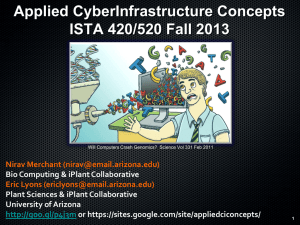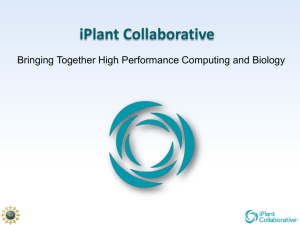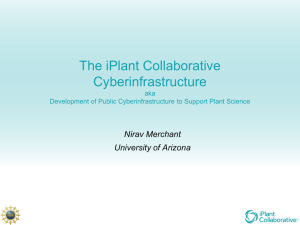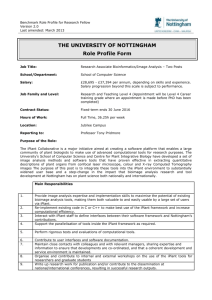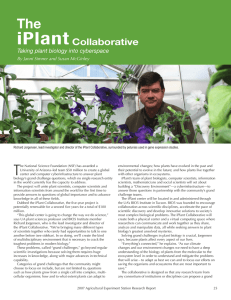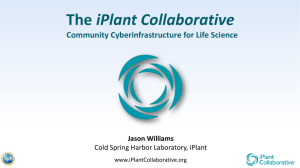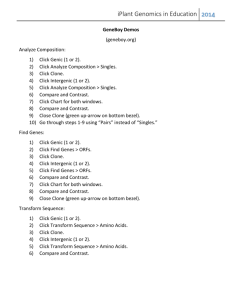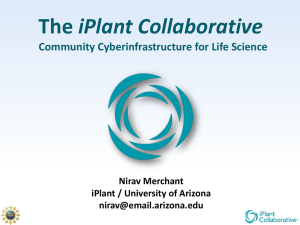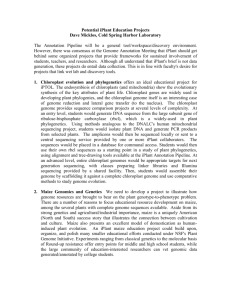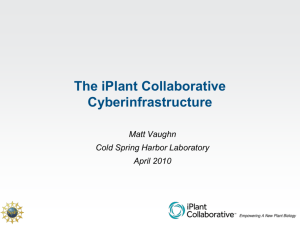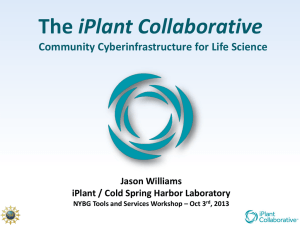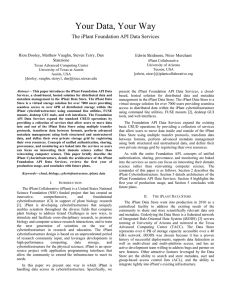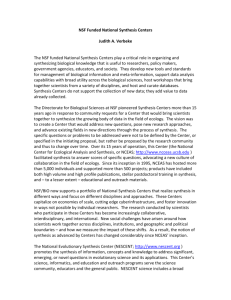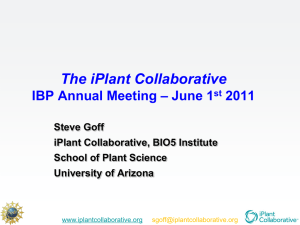The iPlant Collaborative Cyberinfrastructure
advertisement
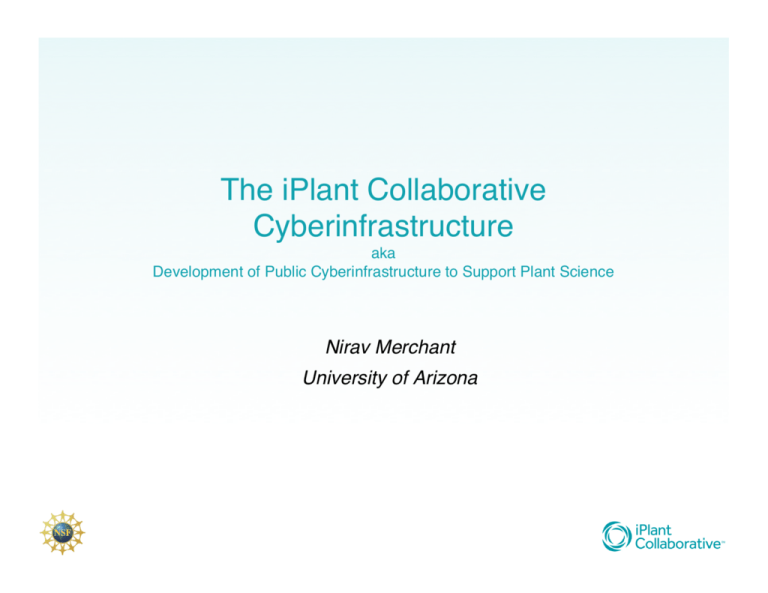
The iPlant Collaborative Cyberinfrastructure aka Development of Public Cyberinfrastructure to Support Plant Science " Nirav Merchant! University of Arizona! PowerPoint Does Rocket Science--and Better Techniques for Technical Reports Essay by Edward Tufte What is iPlant?" • iPlantʼs mission is to build the CI to support plant biologyʼs Grand Challenge solutions" • Grand Challenges were not defined in advance, but identified through engagement with the community" • A virtual organization with Grand Challenge teams relying on national cyberinfrastructure " • Long term focus on sustainable food supply, climate change, biofuels, ecological stability, etc" • Hundreds of participants globally… Working group members at >50 US institutions, USDA, DOE, etc." Brief History" • Formally approved by National Science Board – 12/2007" • Funding by NSF – February 1st, 2008 " • iPlant Kickoff Conference at CSHL – April 2008" o ~200 participants" Grand Challenge Workshops – Sept-Dec 2008" CI workshop – Jan 2009" Grand Challenge White Paper Review – March 2009" Project Recommendations – March 2009" Project Kickoffs – May 2009 & August 2009" First Release of Discovery Environments – April 2010" The paradigm shi- Classic paradigm: You produce data, analyze, interpret (end to end) Conven=onal paradigm: Consor=um/centers produce data and you consume it New Paradigm: Consor=um/centers have produced data and crea=ng “cyber infrastructure” to tackle the “grand challenge” GC Projects Recommended by the iPlant Board of Directors March 2009 Initial Projects: Plant Tree of Life – iPToL – May ʻ09 "+Taxonomic Intelligence "+ APWeb2 "+ Social Networking Website Genotype to Phenotype – iPG2P – Aug ʻ09 "+ Image Analysis Platform" Trait Evolution, Brian Omeara" – Post-tree analysis and mapping of ancestral traits" Tree Reconciliation, Todd Vision" – Large-scale reconciliation of gene trees, co-evolving parasites, etc., with species trees" Big Trees, Alexandros Stamatakis" – HPC Phylogenetic inference with 500K taxa" Tree Visualization Michael Sanderson; Karen Cranston" – Cross cutting group for the viz needs of all! Data Integration, Val Tannen, Bill Piel" – Cross cutting group for the data integration needs of all" Data Assembly, Doug Soltis, Pam Soltis, Michael Donoghue" – Community and network building, data assembly" iPlant Genotype to Phenotype Working Groups" • NextGen Sequencing" – Establishing an informatics pipeline that will allow the plant community to process NextGen sequence data" • Statistical Inference" – Developing a platform using advanced computational approaches to statistically link genotype to phenotype" • Modeling Tools" – Developing a framework to support tools for the construction, simulation and analysis of computational models of plant function at various scales of resolution and fidelity" • Visual Analytics" – Generating, adapting, and integrating visualization tools capable of displaying diverse types of data from laboratory, field, in silico analyses and simulations" • Data Integration" – Investigating and applying methods for describing and unifying data sets into virtual systems that support iPG2P activities" What is Cyberinfrastructure? (Originally about TeraGrid)" WWW.TERAGRID.ORG It was six men of Indostan, To learning much inclined, Who went to see the elephant, (Though all of them were blind), That each by observation Might satisfy his mind. It’s a Grid! It’s a Network! They are HPC Centers! It’s a Common Software Environ! And More!: - Viz - Facilities - Data collections It’s Apps and Support! It’s Storage! … The iPlant Cyberinfrastructure" User Grand Challenge Workflows, iPlant Interfaces Third Party Tools, iPlant-­‐built Tools, Community Contributed Tools and Data! iPlant Discovery Environments Job Submission Workflow Management Service/Data APIs iRODS, Grid Technologies, Condor, RESTful Services iPlant Middleware Compute Storage Persistent Virtual Machines TeraGrid Open Science Grid UA/ASU/TACC Physical Infrastructure Build a CI that’s robust, leverages national infrastructure, and can grow through community contribution! Open Source Philosophy, Commercial Quality Process" • iPlant is open in every sense of the word:" – Open access to source" – Open API to build a community of contributors" – Open standards adopted wherever possible" – Open access to data (where users so choose). " • iPlant code design, implementation, and quality control will be based in best industrial practice" Portfolio of Activities" • Maintaining a balance of “past, present, future” strategies" – “Past”: make services, systems, and support available to existing bioinformatics projects, either to enhance them or simply make critical tools more widely available. " – “Present” build the best bioinformatics software tools that todayʼs technologies can provide. " – “Future” track emerging technologies, and where appropriate stimulate research into the creation and use of those technologies. " Portfolio of Activities" • In a nutshell:" – 12 Working groups in the two grand challenges, each of which is defining requirements for DE development. " Each group not only has discussions that leads to final projects, but they also spawn prototyping efforts, tech eval projects, tool support projects, etc. " – Services group: provide cycles, storage, hosting, etc. to users. " – A comprehensive technology evaluation program to find, borrow, or build relevant technologies, headlined by the semantic web effort." – A number of ancillary projects related to grand challenges, i.e. APWEB, high throughput image analysis " – The Core development/integration effort. " Systems and Services" • Provide access for problems like these on large scale systems" • Provide the storage infrastructure for biological data (again, in support of existing projects)" • Provide cloud style VM infrastructure for service hosting. " iPlant : Connecting Users, Ideas and Resources" The core foundation component comprises of :" Data layer" Registry and Integration layer" Compute and Analysis layer" Interaction and Collaboration layer" iPlant: Using proven technologies" • Data layer: providing access to raw and ingested data sets including high throughput data transfers! • • • • • • • iRODS" GridFTP , Aspera" Dspace (DuraSpace), OpenArchive initiative" Content Distribution Networks (CDN)" High performance storage @ TACC (Lustre)" MySQL and Postgres database clusters" Connection to established data sources (NCBI, TAIR, Gramene)" • Connection to DataOne, DataNet initiatives" • Cloud style storage (similar to Amazon S3 and Walrus)" iPlant: Using proven technologies" • Registry and Integration Layer: Connecting services, data and meta data elements with semantic understanding ! • Meta data catalog management " • Provenance tracking (W7 model)" • Integrated Registry and Service discovery servers" • Data Client and Data Provider Ontology development Kit" • Semantic Architecture (OWL based SSWAP)" iPlant: Using proven technologies" • Compute and Analysis Layer: Connecting tasks with scalable platforms and algorithms! • Virtualization (Xen clusters)" • High Performance Computing at TACC and TeraGrid" • • • • • Grid (Condor, BOINC, Gearman)" Cloud (Eucalyptus, Nimbus)" Reconfigurable Hardware (GP GPU, FPGA)" Checkpoint & Restart (DMTCP)" Scaling and parallelizing code (MPI)" • Workflow engines (DAGman, Pegasus, Kepler)" iPlant: Using proven technologies" • Interaction and Collaboration layer: Providing end user access to unified services and data, from API to large scale visualization! • • • • • • • • • • Google Web Toolkit (GWT driven front end)" Messaging bus (Java Mule, RabbitMQ, XMPP/Jabber)" RESTful web services (web API access)" Single sign-on/identity management (Shibboleth. Oauth ?)" Transparent HPC integration (TeraGrid science gateway and TACC resources" Integration with desktop applications (via web services)" Collaboration platforms (openmeeting, webex wiki, mailman)" Shared analysis (shared workflows, desktop view)" Sharing data (DOI, persistent URL, CDN, social networks)" Large scale visualization (Large Tree, Paraview, SAGE)" Storage Services" • We have also begun offering storage to a number of projects connected to the grand challenges in some way, as well as iPlant internal." – IRODS interface" – Corral at TACC, a local storage array at UA" • Data arriving now for 1KP project, Gates C3/C4 project. " Cloud Services" • iPlant is now offering “cloud” style hosting services." • Dynamically launch virtual servers hosted by iPlant." • Still in prototype " Arrival of “As a Service” models Cyberinfrastructure Is “Research as a Service” SaaS: So;ware as a Service (e.g. Clustering/Assembly is a service) PaaS: PlaIorm as a Service IaaS plus core so;ware capabiliEes on which you build SaaS (e.g. Hadoop/MapReduce is a PlaIorm) IaaS: Infrastructure as a Service (get computer Eme with a credit card and with a Web interface like EC2) 22 What do working groups want ?" • • • • • • • • Wiki" Shared storage" WebEX" CMS" Google apps" Machine for prototyping/development" Change management s/w (git/svn)" Access to compute grid/cluster" What iPlant wants" • Ability to integrate single sign on (sso) with all services we offer (api, cloud, grid, irods etc)" • Leverage credentials from users home institutions" • Lower the barrier to access while still being secure" • Emphasis on ease of access to “research as a service”" Phases of a project" • Enthusiasm " • Disillusionment " • Panic " • Search for the guilty " • Punishment of the innocent " • Praise and honor for the non-participants " 25
